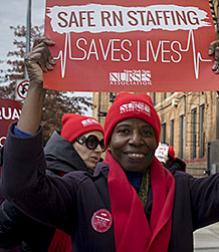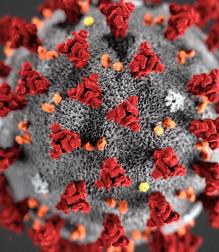After weeks of advocacy and action, we have a final state budget for FY2022-2023 that adds $4 billion to the original Executive Proposal, raising total state spending from $216 billion to $220 billion. The increases are the result of better-than-expected state tax revenues and the massive federal emergency funding for state and local governments that was passed in 2021.
NYSNA members took action to ensure the legislature passed a budget that recognizes frontline caregivers, fights healthcare disparities, and invests in communities. We’re excited to see record investments in healthcare, but we know our work is not done. We remain committed to fighting for healthcare justice priorities like the NY Health Act, fully enforced safe staffing standards, recruitment and retention of healthcare professionals, better public sector pension benefits, expanded nursing scope of practice, fair funding for safety-net and public hospitals, and more. Join us in Albany on April 26!
Here are some highlights from the budget:
Recruitment and retention
- New Nurses Across New York (NANY) student loan forgiveness program targeting direct care nurses who commit to work in healthcare shortage areas, with initial funding set at $2.5 million per year. The budget also added $2 million in funding for the Patricia K. McGee nursing faculty loan forgiveness program.
- Health Care Worker Retention Bonuses: The budget includes state and federal funding to pay direct care health workers COVID recognition and retention bonuses of up to $3,000 under the following terms:
- Covers all public and private employers that participate in Medicaid program;
- Covers all RNs, NPs, Nurse Midwives, CRNAs and other “hands on” direct care workers;
- Payments of up to $3,000 for full-time employees working 35 hours or more, $2,000 for part-timers working 30-35 hours, and $1,000 for part-timers working 20-30 hours;
- Vacation, sick time, and FMLA leaves count as time worked for the purposes of eligibility;
- All employers are mandated by the state to track eligible workers’ hours and pay the bonuses to all eligible employees – participation is not optional;
- Payments will be made in two installments to workers who remain employed for two six-month “vesting periods” that fall between Oct. 1, 2021 and March 31, 2024—the exact vesting periods are to be issued by the Department of Health (DOH);
- Eligible employees are capped at a “base salary” of $125,000 (defined as including all base, experience, and other differentials, but excluding overtime and employee bonuses). NYSNA advocated removing the salary cap entirely, but it was increased from $100,000 to $125,000 to include more registered nurses and other healthcare professionals. We will be calling on employers to voluntarily include senior and advanced practice nurses who make more than $125,000;
- Includes direct care nurses working for hospitals, nursing homes, ambulatory, and out-patient clinics and diagnostic and treatment centers, as well as those employed by local governments, higher education and public and private schools, and school-based clinics (we are still analyzing whether school nurses will qualify);
- Bonus payments will not be subject to state and local income tax, and will not count as income for access to government benefits;
- We will provide more details as the guidelines and policies for payment are issued by the (DOH).
- Tier 6 reforms: The vesting period for Tier 6 and Tier 5 pension plan participants is permanently reduced from 10 years to 5 years. For the period from 4/1/22 to 4/1/24, overtime pay will not be considered for the purpose of determining the amount of employee pension contributions to lessen the impact of COVID-19 overtime work. Overtime will still be counted toward determining “final average salary” for pension calculations. We will continue to advocate for further improvements to the Tier 6 pension plan to improve recruitment and retention of public sector nurses.
Nurse licensure and scope of practice
- NYSNA NPs and allies successfully advocated for the inclusion of some provisions of the Nurse Practitioner Modernization Act. The law is now permanent and expands NP independent scope of practice by removing the requirement that experienced NPs (3600+ hours of practice) maintain collaborative agreements and practice protocols with physicians. The budget does not include a provision NYSNA advocated to allow experienced NPs to oversee less experienced NPs, but we will continue to advocate for expanded scope of practice for NPs and for CRNAs.
- NYSNA helped defeat the Interstate Nurse Licensure Compact proposal which was too broad and posed threats to patient care and nursing standards, while making it easier for employers to hire replacement nurses during a strike.
- Defeated proposals to broadly expand EMS and “medication aide” scope of practice, which posed threats to patient safety and added burdens onto already licensed and unlicensed healthcare professionals.
- Defeated transferring oversight of RN and other licensed professions from the New York State Education Department (SED) to the DOH, which would have increased hospital industry influence on nursing licensure and scope of practice.
Safety-net hospital funding
- Increased across-the-board Medicaid reimbursement rates by 1% and restored prior 1.5% across-the-board Medicaid reimbursement cuts.
- Increased funding for safety-net and distressed hospitals by $990 million for FY2023 (with a commitment for $ 3.9 billion over the next four years). The budget language makes public sector hospitals eligible for funding. It remains unclear how the money will be allocated to eligible safety-net hospitals.
- Includes $1.6 billion in funding targeted to safety-net provider capital projects.
Expanding access to care
- The budget includes various provisions to expand healthcare coverage, including expanding Child Health Plus to mirror Medicaid services, easing income restrictions for Medicaid eligibility for seniors and people with disabilities, extending Medicaid coverage to mothers and newborns for a full year after birth regardless of changes in income, and lowering premium contributions for low-income enrollees in the Essential Plan.
- The final budget will also expand coverage under the Essential Plan to undocumented immigrants over age 65. NYSNA continues to push for the NY Health Act and to expand Essential Plan coverage to cover all uninsured New Yorkers.
- Increased state funding for local health departments’ base grants, including fringe benefit costs. The budget bill did not remove the lower reimbursement rate for New York City (20% versus 36% for the rest of the counties), but NYSNA will continue to advocate to fix that unfair penalty.
- Did not eliminate the “global cap” on Medicaid spending but includes an improved formula that increases the cap substantially, allowing for expanded coverage and providing more funding flexibility for our hospitals and nursing homes.
- Keeps “prescriber prevails” rules for Medicaid patients, allowing drug prescriptions based on provider’s best judgement.
- Provides a 5.8% cost of living adjustment (COLA) for human services workers in non-profit providers who have not had raises in years.
Education
- Record investments in education, including increased foundation aid, support for public higher education institutions like SUNY and CUNY, and funding for mental health support for students and educators.
Childcare
- $7 billion for childcare over 4 years to increase childcare subsidy eligibility from 200% of the Federal Poverty Level (FPL) to 300% FPL, making an additional 400,000 children eligible for subsidized care.
- Substantial wage increases for providers and funding for capital improvements to childcare facilities.
Climate
- Several positive initiatives including funding for offshore wind projects and supply chain investments; funding toward zero-emissions school buses; and a substantial investment in an environmental bond act to support green infrastructure, prevailing wages, and more.
Download and share this budget summary.




